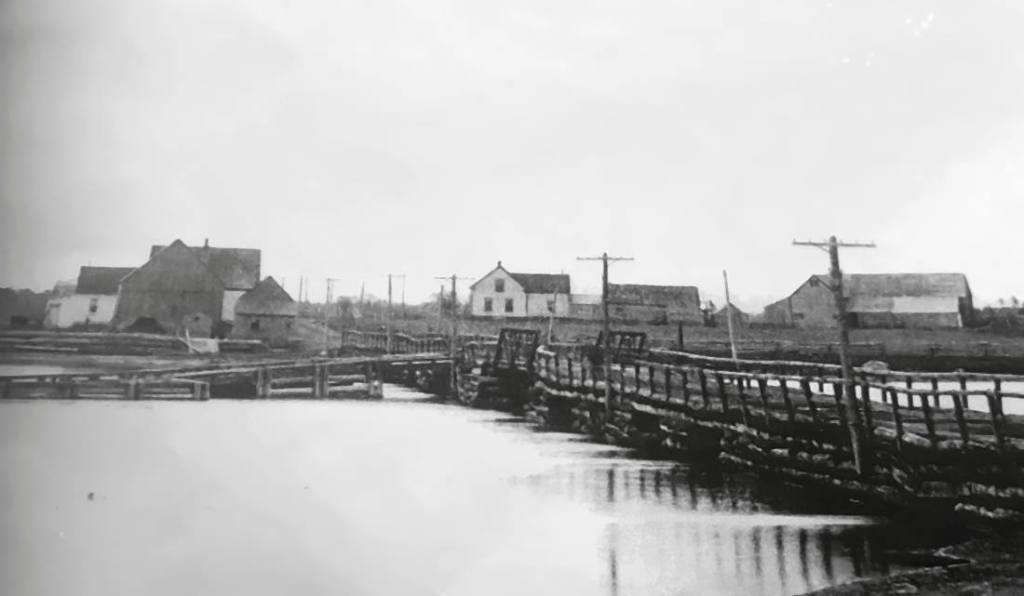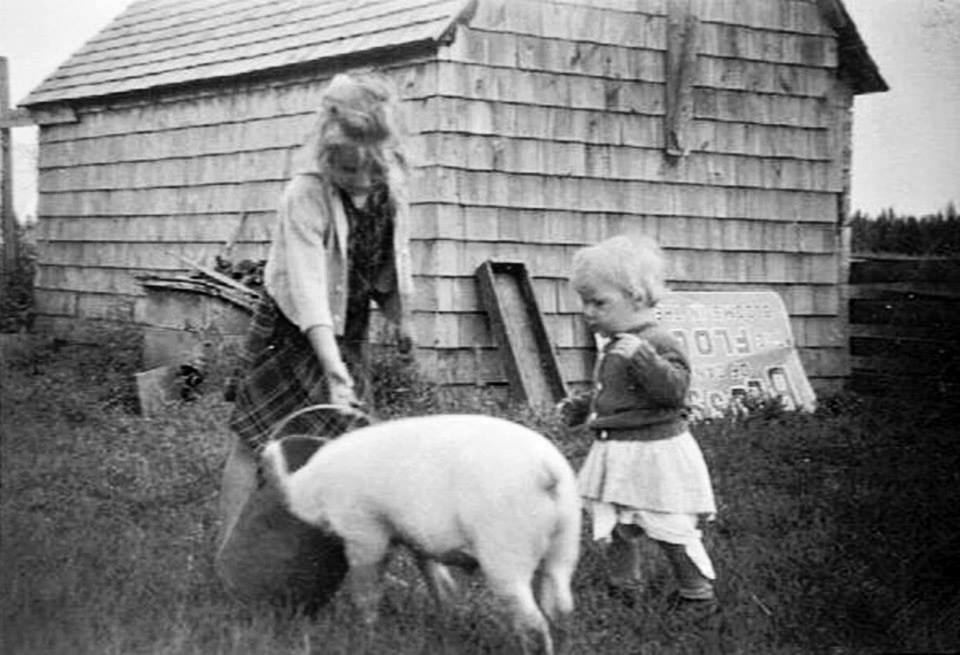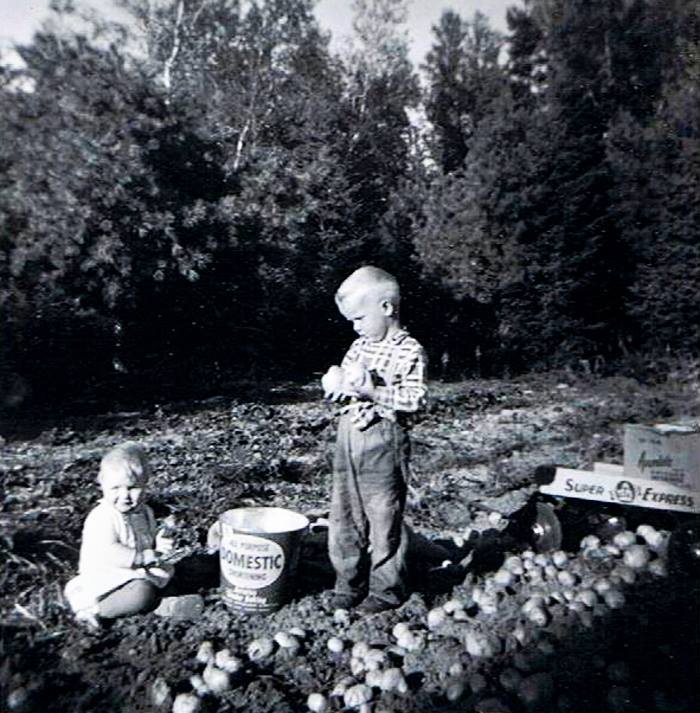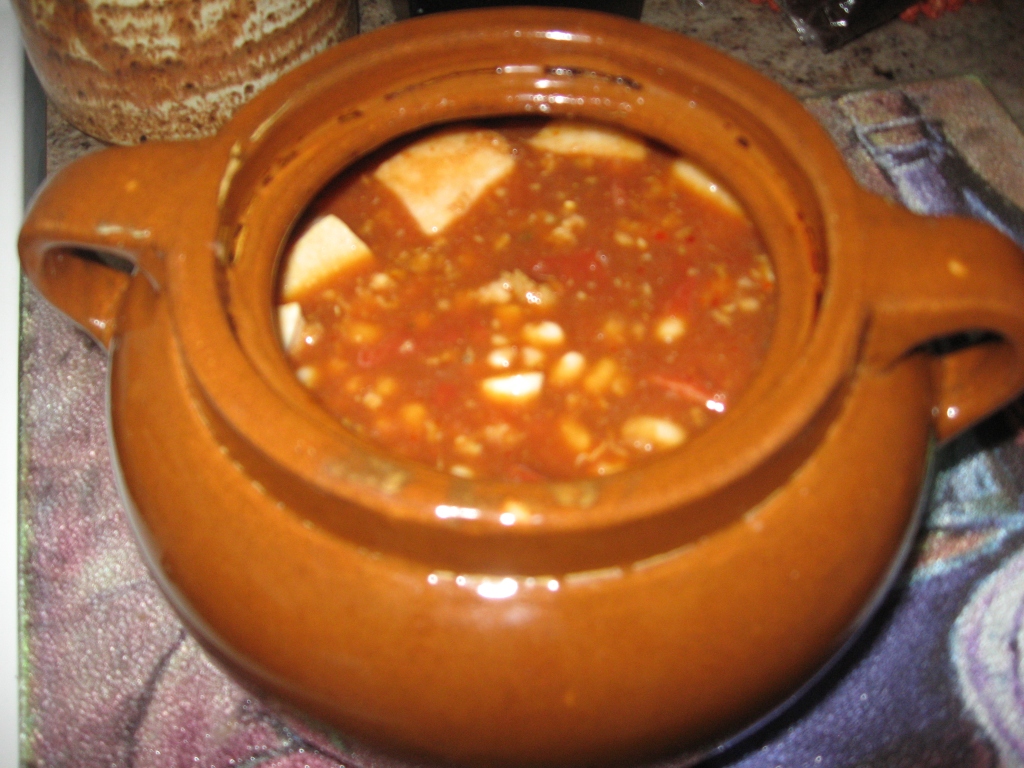This blog is the first in a series which will feature early Scottish settlers to the Atlantic region and the McDougald, MacEachern; McKinnon and McGraw families among others…
The tradition of enjoying a Saturday night supper of homemade baked beans is one familiar to families through out Atlantic Canada. Of course there are several versions for baked beans in the My Mother’s Cookbook collection, most are Maritime style. Whether the recipe calls for fresh pork fat, or bacon, molasses and brown sugar or just molasses, the real question is not how these recipes differ, but what they were served with…

There are plenty of choices for what to serve with baked beans, starch or protein, veggie or grain. Some areas of the region see starchy foods preferred, like Brown bread, or biscuits, some folks add protein in the form of ham, or sausage. Of course there are the wieners and bologna (baloney) group1.

First Nations Peoples were preparing a style of baked beans for generations prior to European settlement, using beans native to the Americas2. Introduced to European settlers by their First Nations neighbours, beans were originally cooked over an open fire. Like many recipes Maritime Baked Beans (aka Boston Style or New England Style) developed over time with the ingredients folks had available to them.
For Mary McDougald’s family the decision to leave their home in Morvern Scotland was the result of on going religious persecution and the fear of Religion of the Yellow Stick3. In 1772 Mary, a toddler and her family immigrated to St Jean’s Island4 with a group, sponsored by John McDonald 8th Laird of Glenaladale, which became known as the Glenaladale settlers.

Jane Sharpe arrived in New Brunswick at the end of the Revolutionary War. Jane’s husband Gregor McKinnon, who was born in Isle of Skye, and served in India with the British Military had been a settler in North Carolina prior to the War. Jane’s family were early settlers to the Massachusettes and Connecticut, beginning in the mid 17th century. After the Revolutionary War, Gregor who was granted land in New Brunswick on the Madame Keswick chose instead to relocate to the Eastern coast of New Brunswick, on Miramichi Bay. It quite likely the McKinnon family chose the location because it offered a community of other Scots to live among.
The earliest sizable group of Scottish settlers to the Eastern region of New Brunswick were sponsored by William Davidson5. The first of the Davidson settlers, Protestant Scots, began arriving on the shores of Miramichi Bay in 1766. At the end of the Revolutionary war, a significant number of former British Military6, including the McKinnon family, many associated with North Carolina Volunteers and the 42nd Highlanders (Black Watch) joined the Davidson settlers in developing the region.

Although the Glenaladale settlers were grateful to the McDonald for sponsoring their move, many of the settlers saw it as an opportunity to leave the precarious life as tenant farmers behind and acquire freehold land. Mary’s family, appear to have been among the group motivated by both land ownership and adherence to their Roman Catholic faith.

The Glenaladale settlers, like any group of Highland Gaels needed both a piper and a priest. Angus Bernard MacEachern, joined his family in Isle St Jean about 1790, eventually becoming the first Bishop of Charlottetown. Serving the Gaelic speaking Scots on Isle St Jean, Father MacEachern, also served the growing Gaelic speaking community in Pictou and Antigonish7 areas of Nova Scotia. When his brother Ewan MacEachern and his wife Mary McDougald relocated to what would eventually become Inverness County Cape Breton Island8, the tiny settlement depended on Father MacEachern for religious service.
Father MacEachern’s decision to guarantee those of the Highland Gaelic families who settled in the region of the Northumberland Strait9 access to Mass in Gaelic saw many families making that choice. Father MacEachern’s plan was a practical one, his flock would be accessible by water, the terrain in many areas was similar to that of their homeland, and sheltering and settling together brought opportunities for shared language, music, culture, kinship and food. As the large number of United Empire Loyalists flooded the region at the end of the Revolutionary War, many with Scottish heritage were drawn to where kin and culture could be found, including on the shores of the Northumberland strait and Miramichi Bay.

Winters for Mary and Jane were difficult, their winter diet dependent upon what they had been able to grow, harvest, forage and preserve. Fishing provided not only a household source of food but also a source of income to purchase items like molasses, tea, etc. Salted and dried fish, dried beans, and potatoes, were staples.
Lands bordering the Northumberland strait are surprisingly varied, soil, topography and climate serving to make some areas sheltered and fertile, others exposed and barren, limiting food and crop choices.

Mary and Ewan, living on the steep hillsides of Inverness county, would have grown both oats and wheat on their farm. Jane and Gregor would have grown some oats as well as buckwheat which is better suited to the northern end of the Northumberland Strait and Miramichi Bay area.

Baked Beans were familiar fare to Jane, Mary less so but she would have learned quickly the value of beans as a source of protein and carbohydrates in the cold climate. Their beans were made with what was available, sometimes maple syrup rather than molasses, maybe even bear fat instead of pork fat.
And what were their beans served with? Jane would probably prefer cornbread or Brown Bread (steamed), but corn and wheat were not always available as they had been in New England. Buckwheat pancakes are a more likely choice if Jane preferred a starch with her beans. It is possible she might have joined Mary in serving Fishcakes with her beans. After all both Mary and Jane lived on some of the most productive fishing areas in North America, the Northumberland Strait and Miramichi Bay region.

My Mother’s Cookbooks Maritime Baked Beans and Salt Cod Fishcakes
Baked Beans
Ingredients:
3 cups of Navy Beans, soaked and parboiled
1/4 cup + 3 Tbsp of Molasses
6 oz of Salt Pork or 6 slices of Bacon cut in to pieces
1 large onion chopped
1 tsp dry mustard
3 tsp white or apple cider vinegar
1 Tbsp Brown sugar
water
1/2 tsp pepper
2 tsp salt or to taste
Method:
1. Preheat oven to 325 degrees F.
2. Wash beans well and remove debris;
3. Place beans in a large bowl and cover with water, let soak overnight in the refrigerator;
4. Drain the beans, place in a large pot, cover with water, bring to a boil and simmer about 40 minutes or until the bean skins crack and split when blown on;
5. Drain the beans and place in a bean crock;
6. Add remaining ingredients except the salt, add enough water to just cover the beans;
7. Cover and bake until the beans are tender about 3 hours, adding water as necessary, during the last hour of cooking, add the salt to the beans.
Salt Cod Fishcakes
Ingredients:
1 Pound of Salt Cod soaked
2 1/2 Pounds of Potatoes, washed, and pared
1 Onion chopped fine
2 Eggs
1/4 Black pepper
Salt to taste
Cornmeal for dusting
Oil for frying
Method:
1. Drain the fish and add it to a pot with potatoes, bring to a boil and simmer until the potatoes are tender, drain;
2. Mash the potatoes and flake the fish into small pieces;
3. Add onion, egg and seasonings, mix well;
4. Using a 1/4 c measure portion and form the fishcakes;
5. Dust the fish cakes in cornmeal;
6. Heat oil and place fishcakes into a frying pan over medium heat, fry until the cakes are lightly browned and cooked to an internal temperature of 155 degrees F.
References:
- Bologna or Boloney as it is known in Atlantic Canada is reputed to have arrived in the region in the very early days of settlement courtesy of an Italian immigrant. Regardless, its origin boloney which is also known as Newfie steak, remains popular in the entire Atlantic region. Maple Leaf Canada (one of the most beloved bologna brands in Canada) report that 60% of bologna sold Canada-wide is bought in Atlantic Canada. Quite impressive for a region that only has about 7% of the country’s population. Of course, like wieners, its salty meatiness goes well with sweet Maritime Baked Beans.
- The varieties of beans commonly used in Maritime Baked Beans are “Navy” beans, which originated in the Americas, along with other varieties.
- Religion of the Yellow Stick – Creideamh a’ bhata-bhuidhe refers to the practice of some Scottish landowner’s attempt to force their tenants to convert to Protestantism.
- Canada’s smallest province, Prince Edward Island was known first as Epekwitk, meaning lying in the water, the first European settlers called the island, Isle St Jean. In November 1798, it was renamed Prince Edward Island.
- Davidson Settlers – William Davidson and his business partner John Cort were awarded a settlement grant of 100,000 acres of land on the Miramichi River in New Brunswick. In exchange for settling the area with Protestant immigrants, Davidson and Court would receive generous land and business grants. Many of those who settled the area were of Scottish heritage.
- The history of conflict between the Scottish and English is well understood, but the role of Scottish soldiers in British Military history aboard may be less so. After Culloden and the Jacobite rebellion of 1745, despite its contradiction large numbers of Scottish men joined the British Army. It appears poverty and a desire to serve and protect their local interests through militia units like the Black Watch is where it began. With in a short period of time, the Crown began using the Scottish militia units as regular army troops in their wars overseas, including in North America. By the 1770’s those considering a move from Scotland to the Colonies, had benefit of the knowledge and experience (theirs and others) gathered by Soldiers serving with English in the French /English Wars.
- The Hector Settlers to Nova Scotia – Just after the Glenaladale settlers arrived in Isle St Jean in 1773, the first major Scottish settlers to Nova Scotia arrived on the Ship Hector. https://www.scotland.org/features/the-hector-settlers-creating-a-new-scotland-in-canada
- The settlement of Inverness County, Nova Scotia began with Scots from Isle St Jean and Pictou area moving east. https://www.electricscotland.com/canada/inverness/chapter17.htm
- The Northumberland Strait – are waters between Prince Edward Island and coastal areas of New Brunswick and Nova Scotia. The northern boundary is between Escuminac NB and North Cape, PEI, while it’s eastern boundary is between West Point PEI and Inverness County, NS an area stretching some 225 km. https://www.thecanadianencyclopedia.ca/en/article/northumberland-strait

Interesting story. I used to enjoy baked beans with mum’s homemade raisin brown bread. Thank you.
Keith L
Sent from my iPad
>
LikeLiked by 1 person
As the youngest member of a very very large family and having grown up in a coal mining community, I am very familiar with baked beans being served with just about everything under the sun. My all-time favorite, I must admit, was a left over Baked Bean sandwich, with lots of mustard, on ma’s homemade bread. As I now visualize my mothers coveted bean crock, I welcome the warm loving feeling it conjures up for me. Great article, much appreciated.
LikeLiked by 1 person
Great and interesting article on the scots settlement in PEI, and this is the the second time I’ve heard Black Watch, first was when I asked my step father if he was a mason, his reply was no, I’m Black Watch
LikeLike
Lots of history in the BlackWatch, a militia unit initially.
LikeLike
i love this sight, I am from N,B,Home baked beans with pancakes, still love them thank you for this post,
LikeLiked by 1 person
Stay tuned to this site! There is more to come.
LikeLike
Brought back to me some beautiful memories. As I read about the McKinnon story, I realize they could ver6 well be my ancestors. My people came from the Isle of Skye, emigrated first to New Brunswick, then Cape Breton. …maybe, just maybe. As for the different spellings of the last name ( McKinnon or MacKinnon), some of my uncles spelled their last name with a Mac, others Mc. …..in the same family! Regardless, such interesting pieces of history. Thank you!
LikeLike
I love this…My husband McKInnon’s are of Cape Breton too, also Skye. The McKinnon’s in this piece are my McKinnons. Lol. Stay tuned I have more I will be doing on the McKinnons. A large number of early CB have PEI connections, including some of the McKinnons. DNA is helping reveal the connections.
LikeLike
Really enjoyed this article and info. I loved my grand mothers home made baked beans. Yummmm!
LikeLiked by 1 person
Fish cakes without summer savory ?..no thanks..
LikeLike
hum…going to have to give this a try.
LikeLike
I have Scots on my my mother’s side from Argyle to PEI and to Gloucester, MA. Then, again on my father’s side through Ireland to New Hampshire. So, I’m not sure where our family’s old tradition of Saturday night beans came from. Thank you for your presentation. It really resonated with me. Now to acquire a bean pot to resurrect this lovely bit of historical cuisine!
LikeLike
I am so glad you enjoyed it.
LikeLike
Wonderful story telling and recipes. Thanks SO much! I might add, that soaked overnight, pretty much this recipe works great in my Ninja Foodi instant pot in a fraction of the time as slow cooked.
LikeLike
TY for that great advice.
LikeLike